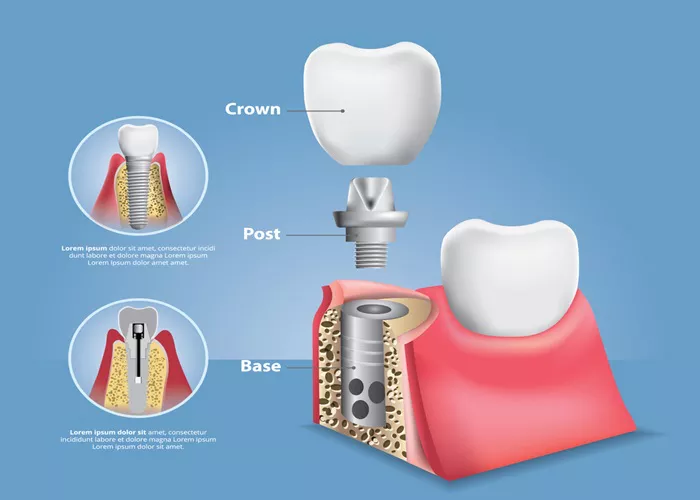Implant crowns, also known as dental implants or artificial teeth, are an advanced dental restoration technique used to replace missing teeth. They provide a durable, stable, and aesthetically pleasing solution for patients with missing teeth. This article will provide a detailed introduction to the materials used in making implant crowns, with simple sentences and logical explanations.
Overview of Implant Crowns
Implant crowns are artificial teeth that are attached to dental implants, which are surgically placed into the jawbone to act as a tooth root. These implants integrate with the bone over time, providing a stable foundation for the replacement tooth. The implant crown, which sits atop the implant, is designed to mimic the appearance and function of a natural tooth.
Materials Used in Implant Crowns
Implant crowns can be made from a variety of materials, each with its own unique properties and benefits. The most common materials include porcelain, zirconia, metal, and a combination of these materials.
1. Porcelain
Porcelain is a popular material for implant crowns due to its excellent aesthetic properties. It can be matched to the color and translucency of natural teeth, providing a seamless and natural-looking restoration. Porcelain is also durable and can withstand the forces of chewing and biting. However, it may be less resistant to wear and chipping compared to some other materials.
2. Zirconia
Zirconia is another popular choice for implant crowns. It is a strong and durable ceramic material that is highly resistant to wear and chipping. Zirconia crowns can also be made to closely match the color and appearance of natural teeth. Additionally, zirconia has excellent biocompatibility, meaning it is well-tolerated by the body and unlikely to cause an allergic reaction.
3. Metal
Metal crowns, such as those made from gold or alloys, have been used for many years in dental restoration. They are strong and durable, capable of withstanding the forces of chewing and biting. However, metal crowns may not match the color of natural teeth, resulting in a visible restoration that can be noticeable when smiling or laughing. For patients who are concerned about aesthetics, metal crowns may not be the best choice.
4. Combination Materials
Combination materials, such as porcelain-fused-to-metal (PFM) crowns, offer a balance of aesthetics and durability. The metal substructure provides strength and stability, while the porcelain veneer mimics the appearance of natural teeth. PFM crowns can be matched to the color and translucency of surrounding teeth, providing a more natural-looking restoration. However, the metal substructure can sometimes be visible at the gum line, especially in patients with thin gums or a gummy smile.
Fabrication Process of Implant Crowns
The fabrication process of implant crowns involves several steps, from initial planning and preparation to final placement.
1. Implant Placement
The first step in the fabrication process is the placement of the dental implant. This involves a surgical procedure to insert the implant into the jawbone. The implant is allowed to heal and integrate with the bone over a period of several months. During this time, the bone grows around the implant, securing it in place.
2. Abutment Attachment
Once the implant has integrated with the bone, an abutment is attached to the top of the implant. The abutment serves as a connector between the implant and the crown. It can be made from a variety of materials, including titanium, zirconia, or porcelain. The abutment is carefully shaped and positioned to ensure that the crown will fit properly and function as intended.
3. Crown Fabrication
The next step is the fabrication of the crown. This involves taking impressions of the teeth and jaw, which are used to create a custom-made crown. The crown is then crafted from the chosen material, taking into account the patient’s aesthetic preferences and functional needs. The crown is carefully shaped and polished to ensure a smooth and natural-looking finish.
4. Crown Placement
Finally, the crown is attached to the abutment using dental cement or a screw. The cement is allowed to set, securing the crown in place. The patient is then given instructions on how to care for their new implant crown, including proper brushing and flossing techniques.
Popular Science: Understanding the Benefits and Considerations of Implant Crowns
Implant crowns offer several benefits for patients with missing teeth. They provide a stable and durable restoration that can last for many years with proper care. Implant crowns also mimic the appearance and function of natural teeth, allowing patients to eat, speak, and smile with confidence.
However, there are also some considerations to take into account. The placement of dental implants involves a surgical procedure, which may carry some risks and side effects. Additionally, the cost of implant crowns can be higher compared to other restoration options, such as bridges or dentures. Patients should carefully weigh the benefits and risks of implant crowns in consultation with their dentist.
Conclusion
In conclusion, implant crowns are a highly effective and aesthetically pleasing solution for patients with missing teeth. They are made from a variety of materials, each with its own unique properties and benefits. The fabrication process involves several steps, from implant placement to crown placement. With proper care and maintenance, implant crowns can provide a durable and natural-looking restoration that enhances the patient’s quality of life.
Related topics:

